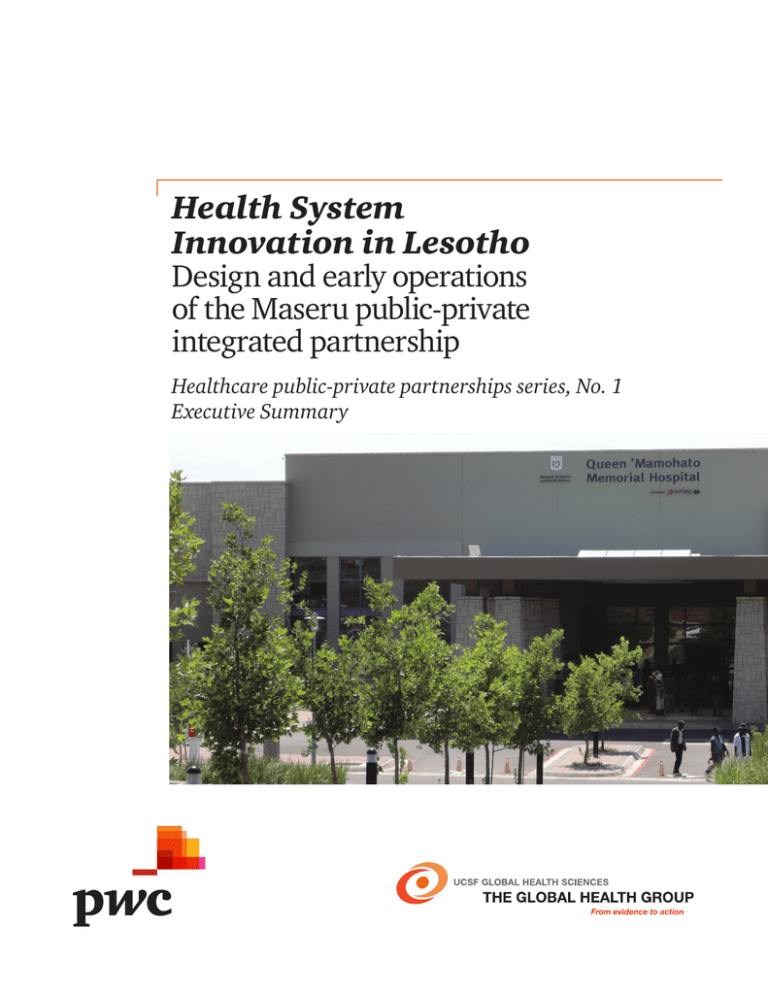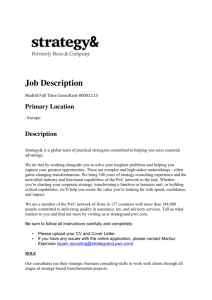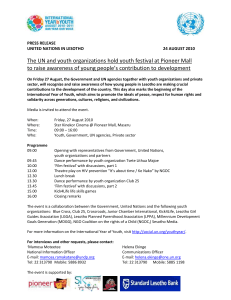
Health System
Innovation in Lesotho
Design and early operations
of the Maseru public-private
integrated partnership
Healthcare public-private partnerships series, No. 1
Executive Summary
Copyright © 2013 PwC and The Regents of the University of California
The Global Health Group
Global Health Sciences
University of California, San Francisco
50 Beale Street, Suite 1200
San Francisco, CA 94105 USA
Email: ghg@globalhealth.ucsf.edu
Website: globalhealthsciences.ucsf.edu/global-health-group
PwC
300 Madison Avenue
New York, NY 10017
Website: www.pwc.com/global-health
Ordering information
This publication is available for electronic download from the Global Health Group’s
and PwC’s websites.
Recommended citation
Downs S., Montagu, D., da Rita, P., Brashers, E., Feachem, R. (2013). Health
System Innovation in Lesotho: Design and Early Operations of the Maseru Public
Private Integrated Partnership. Healthcare Public-Private Partnerships Series, No.1.
San Francisco: The Global Health Group, Global Health Sciences, University of
California, San Francisco and PwC. Produced in the United States of America. First
Edition, March 2013.
This is an open-access document distributed under the terms of the Creative
Commons Attribution-Noncommercial License, which permits any noncommercial
use, distribution, and reproduction in any medium, provided the original authors
and source are credited.
Images
Cover photo provided courtesy of Richard Feachem. Acknowledgements
We are grateful for the expertise and experience so generously shared during the
development of this report. While the report was prepared by the UCSF® Global
Health Group and PwC, information and insights contained in the report were
provided by the following organizations:
• Apparel Lesotho Alliance to Fight AIDS (ALAFA)
• Clinton Health Access Initiative (CHAI)
• Ditau Health Solutions
• The Healthcare Redesign Group
• Lesotho Boston Health Alliance (LeBoHA)
• Lesotho Ministry of Health and Social Welfare
• Lesotho Ministry of Finance and Development Planning
• Millennium Challenge Corporation
• Netcare Limited
• Partners in Health
• Tsepong (Pty) Ltd
• The World Bank Group
Healthcare public-private partnerships series, No. 1
3
UCSF®/PwC report series on
public-private partnerships
About the report series
This report on the Queen ‘Mamohato
Memorial Hospital and the publicprivate integrated partnership
(PPIP) formed for the design,
construction and operation of the
hospital (including the provision of
clinical services) is the first in a series
of publications on public-private
partnerships (PPPs) to be jointly
authored by the UCSF® Global Health
Group and PwC. This series aims
to highlight innovative PPP models
globally and to disseminate lessons
learned and leading practices for the
benefit of current and future projects
around the world.
About the Global
Health Group
The Global Health Group at the
University of California, San Francisco
(UCSF®), Global Health Sciences is an
“action tank” dedicated to translating
major new paradigms and approaches
into large-scale action to positively
impact the lives of millions of people.
Led by Sir Richard Feachem, formerly
the founding Executive Director
of the Global Fund to Fight AIDS,
Tuberculosis and Malaria, the Global
Health Group works across a spectrum,
from research and analysis, through
policy formulation and consensus
building, to catalyzing large-scale
implementation of programs in
collaborating low- and middleincome countries.
One of the Global Health Group’s
programmatic focus areas is the role
of the private sector in health systems
strengthening. The Global Health
Group studies a variety of innovative
delivery platforms that leverage the
strengths of the private sector to
achieve public health goals. The Global
4
Health System Innovation in Lesotho
Health Group has identified publicprivate partnerships in general, and
public-private integrated partnerships
in particular, as a promising model
to improve health systems globally,
including in developing countries.
For more information about
the Global Health Group, visit:
globalhealthsciences.ucsf.edu/globalhealth-group.
About PwC
PwC is one of the largest healthcare
professional services firms, advising
governments and private enterprises
on every aspect of business
performance, including: management
consulting, business assurance, tax,
finance, advisory services, human
resources solutions, and business
process outsourcing services.
PwC’s Global Healthcare practice
includes more than 5,000 health
professionals with expertise in publicprivate partnerships, medicine,
bioscience, information technology,
clinical operations, business
administration and health policy.
As healthcare becomes increasingly
interconnected with other industries,
PwC’s global reach and resources help
governments, businesses and industry
players accomplish their missions in a
dynamic and competitive environment.
For more information visit www.pwc.
com/global-health
About public-private
partnerships
The past three decades have witnessed
a growing tendency by governments
of countries at all income levels to
seek out long-term partnerships with
the private sector in domains such as
transport, infrastructure and energy.
While starting considerably later and
much more cautiously, a parallel trend
has emerged in the health sector. In
the past ten years, there has been a
rapid expansion and acceleration of
interest in public-private partnership
(PPP) models for health, across many
continents and income levels.
PPPs are a form of long-term contract
between a government and a private
entity through which the government
and private party jointly invest in the
provision of public services. Through
this arrangement, the private sector
takes on significant financial, technical
and operational risks and is held
accountable to defined outcomes. PPPs
can be applied across many sectors
and typically seek to capture private
sector capital or expertise to improve
provision of a public service.
PPPs are characterized by the longterm nature of the contract (typically
20+ years), the shared nature of the
investment or asset contribution and
the transfer of some risk from the
public to the private sector. These
features distinguish a PPP from
other contracts existing between
governments and the private sector,
which might not be considered PPPs.
PPPs provide governments with
alternative methods of financing,
infrastructure development and/or
service delivery. Ideally, PPPs also give
private parties the opportunity to “do
well while doing good.”Ref 9 PPPs can
make private capital investment more
attractive to the private sector, reduce
the risk profile for private investment
in new markets or otherwise ease
barriers to entry in new markets, all in
service of defined public policy goals.
In healthcare, the public-private
partnership approach can be applied
to a wide range of healthcare system
needs: construction of facilities,
provision of medical equipment or
supplies or delivery of healthcare
services across the spectrum of care.
While relatively simple “design,
build, finance and maintain” models,
like the British hospitals built under
private finance initiatives (PFIs),
remain the most commonplace, an
increasing number of governments
are experimenting with or considering
more ambitious models, including
public-private integrated partnerships
(PPIPs), which include the provision
of clinical services within the private
sector scope of the PPP. Ref 23
About public-private
integrated partnerships
This case study focuses on the Queen
‘Mamohato Memorial Hospital, a PPIP
in the Kingdom of Lesotho.
PPIPs are a special form of PPP,
designed to achieve significant and
sustainable improvements to health
systems at national or sub-national
levels through both capital investment
and service delivery. Ref 7,23
PPIPs position a private entity, or
consortium of private partners,
in a long-term relationship with a
government to co-finance, design,
build and operate public healthcare
facilities and to deliver both clinical
and non-clinical services at those
facilities for a long-term period. PPIPs
enable governments to prudently
leverage private sector expertise and
investment to serve public policy
goals, specifically the goal of providing
high-quality and affordable preventive
and curative care to all citizens. PPIPs
aim to be “cost neutral” to patients,
who incur the same out-of-pocket
payments, usually zero or minimal,
as they did in the previous, often
dilapidated and perhaps poorly run
public facilities. These facilities revert
to government ownership at the
end of the contract term, ultimately
guaranteeing government ownership
of the facilities. Ref 7,23
PPIPs are characterized by the
following four key attributes:
• A design, build, operate and
deliver (DBOD) model: The
private partner or consortium
designs, co-finances, builds,
operates and delivers clinical care
in one or more health facilities,
often including a tertiary hospital
and surrounding primary and
secondary facilities. This model
is commonly called a “DBOD”.
Unlike other PPPs, PPIPs go beyond
private investment in buildings and
maintenance, as the private partners
are also responsible for delivering
all clinical services at the facilities,
from surgery to immunization to
ambulance services.
A successful PPIP must exist for a
decade or more to give both public
and private partners sufficient time
to develop sustainable systems,
processes and overall operations
based on informed strategic
planning and improvement through
feedback loops.
• Risk transfer: Under the DBOD
model, the private partners, not
the government, are responsible
for meeting defined service quality
benchmarks. In this way, the private
partners assume risk for delays and
cost overruns in the construction
phase as well as ongoing operational
risk including human resource
issues and failure to achieve
efficiency in service delivery.
Governments remain involved in
ensuring service quality through
regulation, contract management
and/or monitoring activities. Ref 7,23
PPIPs are further characterized by
their motivating policy goals:
• Quality of care: Improved quality
of care for all at the PPIP facility and
possibly across the health system;
• Equity of access: Unrestricted
access to PPIP facilities by all,
regardless of income level or
social status;
• Government ownership of
assets: The healthcare facilities
are ultimately owned by the
government upon termination
of the PPIP contract.
• Long-term, shared
investment: A PPIP comprises
a long-term commitment by both
the government and the private
partners to provide health services
for a defined population. Both
partners invest significant resources
into the project, supporting longterm dedication and a common
interest in successful outcomes.
• Cost neutrality: No change in
out-of-pocket costs for patients
utilizing a PPIP healthcare
facility and, in some cases, cost
neutrality for the government’s
annual expenditure for the PPIP
facilities and services relative to
conventionally built and operated
facilities. Where both measures of
cost neutrality are achieved, the
PPIP has achieved “cost neutrality
squared,” or “(cost neutrality)2”;
Healthcare public-private partnerships series, No. 1
5
• Predictable government health
expenditures: Fixed payments to
support predictability in healthcare
budgeting and stability of national
health expenditures; and
• System-wide efficiency gains:
High and transparent standards
for service delivery and outcomes
with the potential for raising
performance expectations and
accountability for the entire national
healthcare system. Ref 7,23
Finally, effective management of
inherently complex PPIPs necessitates
careful monitoring being carried out
independently when necessary. In
an ideal model, a jointly appointed
independent monitor routinely
assesses project performance against
metrics and outcomes mutually
developed by both the public and
private partners. Appropriate penalties
and/or rewards are clearly tied to
assessed performance. Ref 7,23 In previous
publications, the Global Health Group
has noted that data collection around
PPIPs is challenging. Ref 7 In general,
while showing a positive trend, the
available academic literature is lacking
analyses of—and even summary
information on—PPIPs. Often there
are commercial sensitivities and
legalities that inhibit both public
and private actors from revealing
financial data, health outcomes and
other project details. In high-income
countries, political and regulatory
factors (including national audit and
6
Health System Innovation in Lesotho
budgeting departments) can ensure
that upon completion, cost-efficiency
and other data from the project are
made available to the public. In
developing countries, project data
have not been made publicly available,
but greater transparency should be an
important goal for future projects.
We hope that this report and
associated publications, including
future reports in this series, will
enhance the literature and evidence
base for PPIPs (and other innovative
PPP models) and contribute to
a growing understanding of this
important alternative for improving
healthcare infrastructure and clinical
delivery around the world. Some
have argued that PPIP solutions are
not scalable or generally applicable,
especially in very low-income settings.
While low income settings will require
careful specification of required
services versus nonessential services
and careful consideration of the longterm affordability of contract design,
the example presented here clearly
demonstrates that a PPIP solution
is possible even in a resource poor
environment. Still, each PPIP must
be tailor-made for its unique purpose
and circumstances. There are common
lessons and themes, but there are
also myriad details which are siteand context-specific. These details
matter and getting them right is, and
will continue to be, at the heart of
success. Ref 7,23
Methodology
Between January and October
2012, study researchers conducted
qualitative interviews in Lesotho,
South Africa, and the United States.
Participants included employees of
Tsepong (Pty) Ltd, Netcare Limited,
the Lesotho Ministry of Health and
Social Welfare, the Lesotho Ministry
of Finance and Development Planning,
the World Bank Group and multiple
non-governmental organizations
(NGOs) with operations in Lesotho.
The authors of this publication also
conducted grey and peer-reviewed
literature reviews on PPPs, PPIPs and
the Lesotho PPIP specifically to inform
the development of this case study.
Print and web references are listed at
the back of this report, and citations
throughout the document refer to
sources by the numbers established in
this list of references.
Audience
The primary audience for this report
is the governments of low and middleincome countries (LMICs), including
policymakers in ministries of health
and ministries of finance. This report
may also be helpful to others studying
how best to leverage the private sector
to strengthen health systems, including
donor agencies, non-governmental
organizations, academic institutions
and private health entities.
Executive summary
After a decade-long planning effort,
Queen ‘Mamohato Memorial Hospital
(QMMH) opened to serve the people
of Lesotho on October 1, 2011. The
project represented the first time a
Public Private Integrated Partnership
(PPIP) was established in sub-Saharan
Africa and, moreover, in a lower
income country anywhere in the
world. The project was also the largest
government procurement of health
services in Lesotho history.
Lesotho is a small, mountainous nation
of 11,720 square miles (30,335 sq km)
entirely surrounded by the Republic
of South Africa, with a population of
around 2 million people. Lesotho’s
greatest healthcare challenge is the
HIV/AIDS pandemic: 23% prevalence
in the adult population. The Lesotho
healthcare system is predominantly
publicly funded (61% of total health
expenditure, 57% public hospitals),
and healthcare spending represents
11.1% of GDP.
In 2000, it became apparent that the
national referral hospital and district
hospital for Maseru (Lesotho’s capital),
Queen Elizabeth II (QEII) required
replacement. After conducting a
feasibility study and evaluating
multiple alternatives, the Government
elected to proceed with a PPP solution
for hospital replacement. After
engaging transaction advisors, the
Government issued a tender for a
PPIP project, posing the question to
the private sector: for the same level
of expenditure at QEII, how much
more can the private sector provide
in quality, breadth and volume of
healthcare services?
Following a competitive tender
process, Tsepong (Pty) Ltd, a
consortium comprised of the private
South African hospital operator
Netcare and various local partners,
was selected as the preferred bidder
and ultimately contracted with the
Government to design, build and
construct a 425-bed (390 public beds,
35 private beds) hospital and attached
gateway clinic, refurbish and re-equip
three urban filter clinics and then
provide all clinical and non-clinical
services for the duration of the 18-year
contract. Taken together, the hospital
and filter clinics formed a health
district that supported application of
integrated care to improve efficiency
and expand access to services for
Maseru and the Kingdom of Lesotho.
This ambitious project placed
particular emphasis on health system
strengthening and local economic
development and, if successful, could
provide a template for similar projects
across the African continent.
The Government made significant
up-front payments for hospital
construction and construction
site preparation (approximately
US $58 million) so as to reduce
the risk profile of the project and
reduce downstream annual unitary
payments. Approximately $95 million
in financing was arranged through
the Development Bank of Southern
Africa (DBSA) and the Tsepong
consortium contributed approximately
$500,000 in equity toward capital
expenditures. Annual unitary
payments of approximately $30
million, which reimburse Tsepong’s
capital and operating expenses, were
not scheduled to begin until hospital
construction was complete, so a $6.25
million grant from the World Bank’s
Global Partnership for Output-Based
Aid (GBOPA) was arranged as part of
the PPIP contract.
With the contract, the Government
greatly expanded the scope, quality,
and volume of services available
through the new national referral
hospital with an approximate 7.5%
increase in annual operating cost as
compared to QEII. User fees at QMMH
were equal to fees at other public
hospitals, so patients paid no more for
significantly improved care at QMMH,
which is accessible by referral only.
Independent monitors were appointed
to evaluate the quality of both
construction and operations phases,
and formal structures were established
in the PPIP contract for joint oversight
by Tsepong and the Government.
Healthcare public-private partnerships series, No. 1
7
Direct agreement
Direct agreement
Direct agreement
Government of Lesotho
Lenders
direct agreement
Development Bank of
South Africa
• Lender/Bank
PPIP
agreement
Payment
Debt/equity
Capital/interest
Tsepong, LTD
• Netcare—40%
• Excel Health—20%
• Afri’nnai—20%
• Women Investment Company—10%
• D10 Investments—10%
Payment
RPP Lesotho
• Construction
contractor
Construction
Payment
1 National hospital
1 Gateway clinic
3 Filter clinics
Facilities management
Clinical services
Clinical services
Facilities
management
Patients
While the hospital had only been open
for one year at the time of our data
collection visit, numerous lessons can
still be learned through the Lesotho
experience. Notable challenges to
date include:
• Significant cultural change for
nurses, physicians, and staff
working at QMMH;
• Significant, immediate demand
for healthcare services at the
newly opened filter clinics and
hospital that has greatly exceeded
contract targets in the first year
of operations;
• Challenges for physician
recruitment due to comparatively
low salaries; and
• Payment delays (both the GBOPA
grant and periodic unitary payments
from the Government);
8
Turner and Townsend
• Independent monitor
Health System Innovation in Lesotho
Financers/owners
Direct agreement
• Negative media reaction during the
project’s first months;
Netcare hospitals
• Clinical services
• Soft facilities &
equipment management
Botle Facilities
Management
• Hard facilities
management
Sub-contracting
PD Naidoo
and Associates
• Independent certifier
Operations
Regular inspections
Review & final certifications
Construction
Independent monitor
Figure 1: PPIP contractual design
including improved clinical
outcomes for patients and an
improved work environment for
employees. Operations at QMMH
have been transformed through
application of strong management
systems and leadership, installation
of new equipment and current
information technology. Early
achievements include:
• Delays in establishing PPP units in
the Government and strengthening
the Government’s contract
management capabilities.
• Opening of the first Intensive Care
Unit and Neonatal Intensive Care
Unit in Lesotho;
Despite these challenges, both
public and private parties reported
significant early achievements,
• Reported improvement in maternal
and infant mortality, post-surgical
mortality, and clinical management
of HIV/AIDS and related diseases;
• Establishment of guidelines and
incentives that have translated into
improved staff performance;
• Investment in significant training
programs to enhance the skills
of QMMH employees and
strengthen the broader Lesotho
healthcare system;
• Build government capacity for
contract management from the
outset of the project.
similar PPIP or PPP initiatives,
including the need to:
• Customize the PPP solution to local
healthcare needs, as established
in comprehensive baseline or
feasibility studies;
• Access broad, appropriate expertise,
including local knowledge;
• Immediate reduction in costs
associated with drug purchasing
and the treatment abroad
program; and
• Formation of a strong partnership
between public and private parties.
Despite the early stage of the project,
the Lesotho experience already holds
many lessons for others considering
• Assign strong project leadership
and develop a pipeline of next
generation of public and private
leaders early on;
• Develop extensive plans and
training programs early in the
project effort; and
Overall, the case study of QMMH
demonstrates the ability of a lower
income country to engage the private
sector in new ways and, in a relatively
short period of time, transform the
quality of care being provided to
its population. Future success will
depend on the project’s ability to
weather changes in public and private
leadership and manage significant
demand for healthcare services to
avoid allowing QMMH to become
“an island of excellence” within a
struggling health system. Future
evaluation and greater availability and
transparency of project data will be
essential to establish the impact and
success or failure of the project.
Figure 2: PPIP timeline
October 2008:
Contract execution/
commercial close,
subject to financing clause
Hospital replacement
need identified
2000
2001
IFC retained as
transaction advisors
2002
2003
2004
2005
2006
2007
2008
Completion of
initial feasibility
study to evaluate
options for
replacing QEII
March 2009:
Financing clause
signed/financial
close. Construction
begins
October 2011:
QMMH and Gateway
Clinic open for
business under
Tsepong management
2009
2011
2010
May 2010:
Refurbished
urban filter clinics
open for business
under Tsepong
management
Project tender
documents
issued
October 2007:
Deadline for
vendor
response/bid
submission
2026
March 2026:
Completion of
18-year contract
December 2007:
Preferred bidder
announced
Healthcare public-private partnerships series, No. 1
9
www.pwc.com/global-health
www.globalhealthsciences.ucsf.edu/global-health-group
The Global Health Group
Sir Richard Feachem
Professor of Global Health and
Director
+1 (415) 597 4660
feachemr@globalhealth.ucsf.edu
Dr. Dominic Montagu
Associate Professor and Lead, Private
Sector Healthcare Initiative
+1 (415) 597 8214
montagud@globalhealth.ucsf.edu
PwC
Paul da Rita, UK
Global Healthcare – PPP Leader
+44 0 207 212 5932
paul.da.rita@uk.pwc.com
Sarah Downs, US
Global Health PPP Manager
+1 (415) 498 7557
sarah.e.downs@us.pwc.com
Copyright © 2013 The Regents of the University of California All Rights Reserved.
Copyright © 2013 PwC. All rights reserved. PwC refers to the PwC network and/or one or more of its member firms, each of which is a separate legal entity.
Please see www.pwc.com/structure for further details. This content is for general information purposes only, and should not be used as a substitute for
consultation with professional advisors. PwC helps organisations and individuals create the value they’re looking for. We’re a network of firms in 158 countries with
more than 180,000 people who are committed to delivering quality in assurance, tax and advisory services. Tell us what matters to you and find out more by visiting
us at www.pwc.com. PM-13-0089 SL







